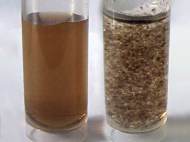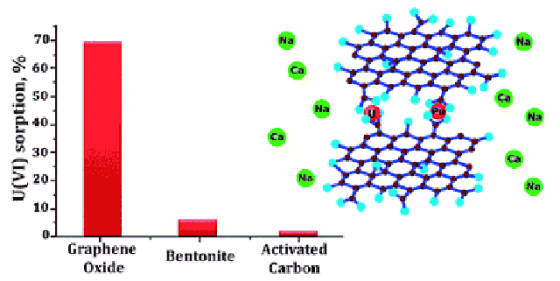Using graphene oxide to remove radiation particles from liquids
 While roboticists efforts to develop robots able to withstand exposure to high levels of radiation are helpful for needed actions and monitoring after disasters with increased levels of radiation, researchers at Rice University and Lomonosov Moscow State University have found that graphene oxide (GO) could actually be used to quickly remove radioactive material from contaminated water.
While roboticists efforts to develop robots able to withstand exposure to high levels of radiation are helpful for needed actions and monitoring after disasters with increased levels of radiation, researchers at Rice University and Lomonosov Moscow State University have found that graphene oxide (GO) could actually be used to quickly remove radioactive material from contaminated water.
A collaborative effort of James Tour, a chemist at the Rice lab, and Stepan Kalmykov, a chemist at the Moscow lab, revealed that atom-thick flakes of GO are able to bind both to natural and human-made radiation particles (radionuclides). Graphene oxide’s large surface area acts as fishing net and it collects radionuclides, coagulates with them, and turns them into solids.
Kalmykov’s group determined how fast is the process, since it defines the capacity of the material to adsorb radionuclides. The researchers tested graphene oxide synthesized at Rice with simulated nuclear wastes containing uranium, plutonium and substances like sodium and calcium that could negatively affect their adsorption. Graphene oxide proved far better than bentonite clays and granulated activated carbon – materials that have been used in nuclear cleanup thus far.
GO introduced to radioactive materials used in the study managed to coagulate within minutes. Aside performing in contaminated water, GO managed to work in acidic solutions (pH < 2). The researchers focused on removing radioactive isotopes of the 30 rare earth elements in the periodic table from liquids, rather than solids or gases.
This approach can be used to capturing radionuclides and make them easier to handle. Once GO is added to contaminated environment, it collects the radionuclides and creates a solid material which is easier to collect. Once collected, the solid material could be stored, processed or even burned. GO burns easily and it leaves a cake of radioactive material that can be reused. Despite the fact that GO is fairly easily produced in bulk, increased environmental caution will force us to devise other methods to separate it from the collected radioactive material.
Aside obvious potential application in radiation contaminated areas such as the site around the Fukushima nuclear plants which were damaged by the 2011 earthquake and tsunami, the technology could be used in mining and drilling.
Naturally occurring radionuclides are also unwelcome in fracking fluids that bring them to the surface in drilling operations. When groundwater comes out of a well and it’s radioactive above a certain level, it can’t be spilled back into the ground. Instead shipping contaminated water to repository sites, drilling companies could use this discovery to purify the water at the drilling site.
For more information, read the article published in the Physical Chemistry Chemical Physics: “Graphene oxide for effective radionuclide removal”.










I wonder what it does to the micro-organisms that could be living in those areas?